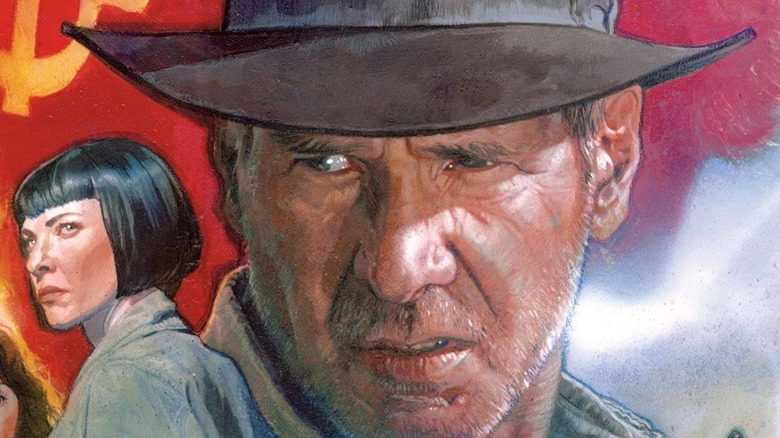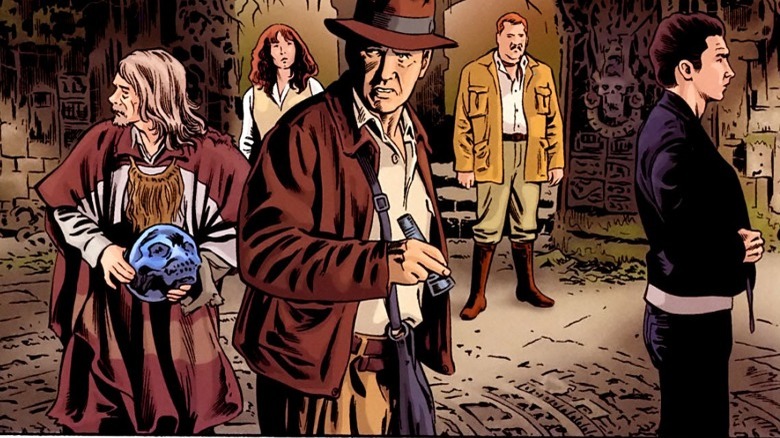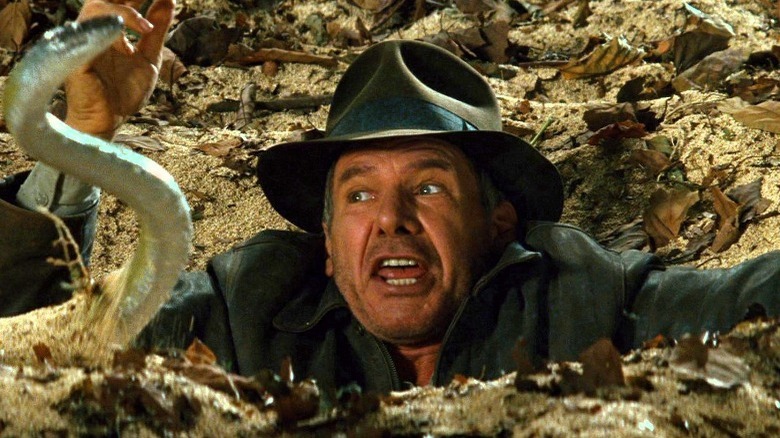Indiana Jones' Crystal Skull Comic Adaptation Fixed A Few Of The Movie's Biggest Issues
Nearly 20 years after his last adventure in 1989's "Indiana Jones and the Last Crusade," Harrison Ford's titular archaeologist finally made his return for another globe-trotting quest in 2008's "Indiana Jones and the Kingdom of the Crystal Skull." Expectations were high for the long-awaited sequel, especially with Steven Spielberg returning to the director's chair. However, the movie was met with tepid-to-negative reactions from fans and critics alike, with outlets calling out faults in some of the film's over-the-top set pieces and excessive CGI.
As of this writing, "Crystal Skull" retains a 53% audience score on Rotten Tomatoes. In contrast, Indy's first outing, "Raiders of the Lost Ark," currently sits at a staggeringly high 96% audience score. While "Crystal Skull" isn't Spielberg's least favorite Indiana Jones movie, it still regularly finds itself at the bottom of most fan rankings, and it introduced to pop culture the term "nuking the fridge" as the cinematic equivalent of television's "jumping the shark" (the phrase even earned itself its own Urban Dictionary page).
However, the movie wasn't the only version of "Crystal Skull" that came out in 2008. A two-issue comic book adaptation from Dark Horse was released to coincide with the film, coming from John Jackson Miller and Luke Ross. While the major story beats remain the same between the movie and the comic, the latter makes some slight alterations to its source material, and in doing so, may have accidentally improved on the movie. Here's how.
Crystal Skull's distracting CGI animals (and vine swinging) are gone in the comics
A common criticism levied against "Indiana Jones and the Kingdom of the Crystal Skull" revolves around its overabundance of CGI, particularly in regard to non-human actors. Some of the standout set pieces from the original trilogy feature live animals, providing an extra level of realism. "Raiders" has the iconic snake pit scene, "Temple of Doom" sees Indy and company navigating tunnels filled with countless creepy crawlies, and "The Last Crusade" features hundreds of live rats that Indiana has to contend with. Practical animal effects were an integral element in the original films.
But with CGI reigning supreme by the time of "Crystal Skull," real animals were replaced by animated ones beginning with the very first scene, which prominently features a CGI prairie dog curiously investigating a race between American teens and undercover Russian operatives. And while it's inarguably a good thing to reduce the number of live animals on movie sets for the sake of their safety, the abrupt shift to purely CGI marked a noticeable departure from the previous movies. The comic omits all of this (as well as the prairie dog's post-fridge reappearance), instead skipping right to the action with Indy in Soviet custody. The prairie dog's removal is minor, but it also avoids setting too silly a tone for the story to follow.
Probably the most heavily-criticized animal-related scene comes when Shia LaBeouf's Mutt Williams swings, Tarzan-style, on vines through an Amazonian jungle alongside an army of monkeys. Whether it was a conscious decision or the creators needing to condense the movie's story, this sequence is entirely left out of the comic. Not only does the choice streamline the action, but it also removes one of the film's most unbelievable moments.
Indiana Jones is less of a joke in the comics version
While Indy was never portrayed as infallible in his first three movies, he was still always at least competent. But at certain points in "Crystal Skull," he can come off as hapless — or almost bumbling. One scene in particular, in which Indy finds himself stuck in a sandpit, presents an uncharacteristically comical version of the adventurer. When his only hope of rescue is using a snake as a tether, Indy panics to such an extent that even his onscreen rescuers are rolling their eyes.
Indy's fear of snakes is well documented throughout the franchise, but this particular sequence is so exaggerated in the film that even his rescuers are seemingly over it as they ensure him that it's a rope, not a snake. This scene still happens in the comic, but the snake portion is contained to just four panels and doesn't require playing make-believe. While shortening the sequence does nothing to alter the plot, it does at least reduce the length of the embarrassing scene.
Though it can be considered an improvement, the comic doesn't fix all of the problems people found with the fourth "Indiana Jones" movie. The plot, for the most part, remains the same, so anyone hoping for a wholly different telling of the story will be disappointed. The fridge is still nuked, aliens still exist, etc. However, by removing some of the more whimsical — arguably silly — aspects of "Indiana Jones and the Kingdom of the Crystal Skull," and by offering a less comical interpretation of the protagonist, the comic adaptation is at least able to avoid some of its counterpart's pitfalls and give fans a story more reminiscent of the original trilogy.


